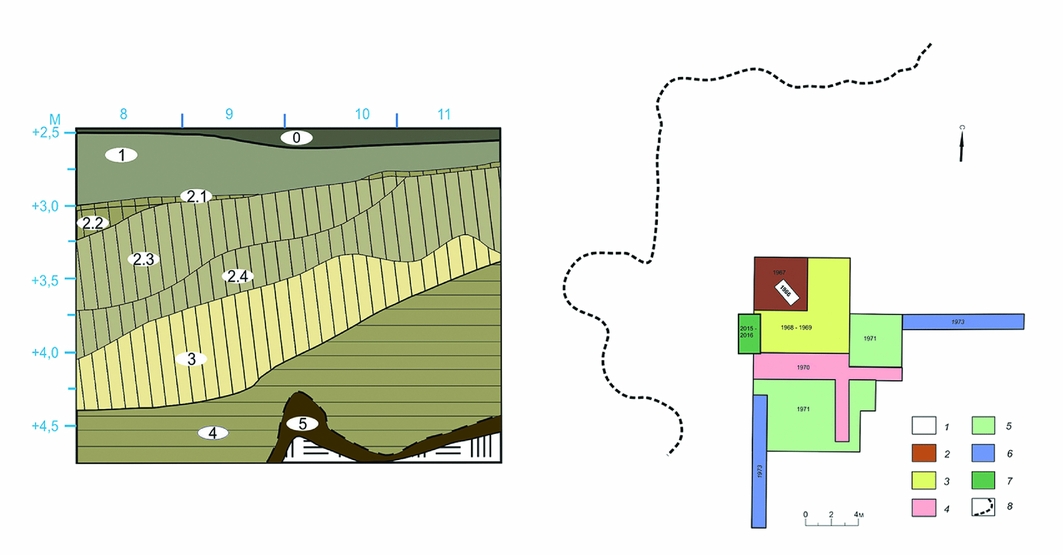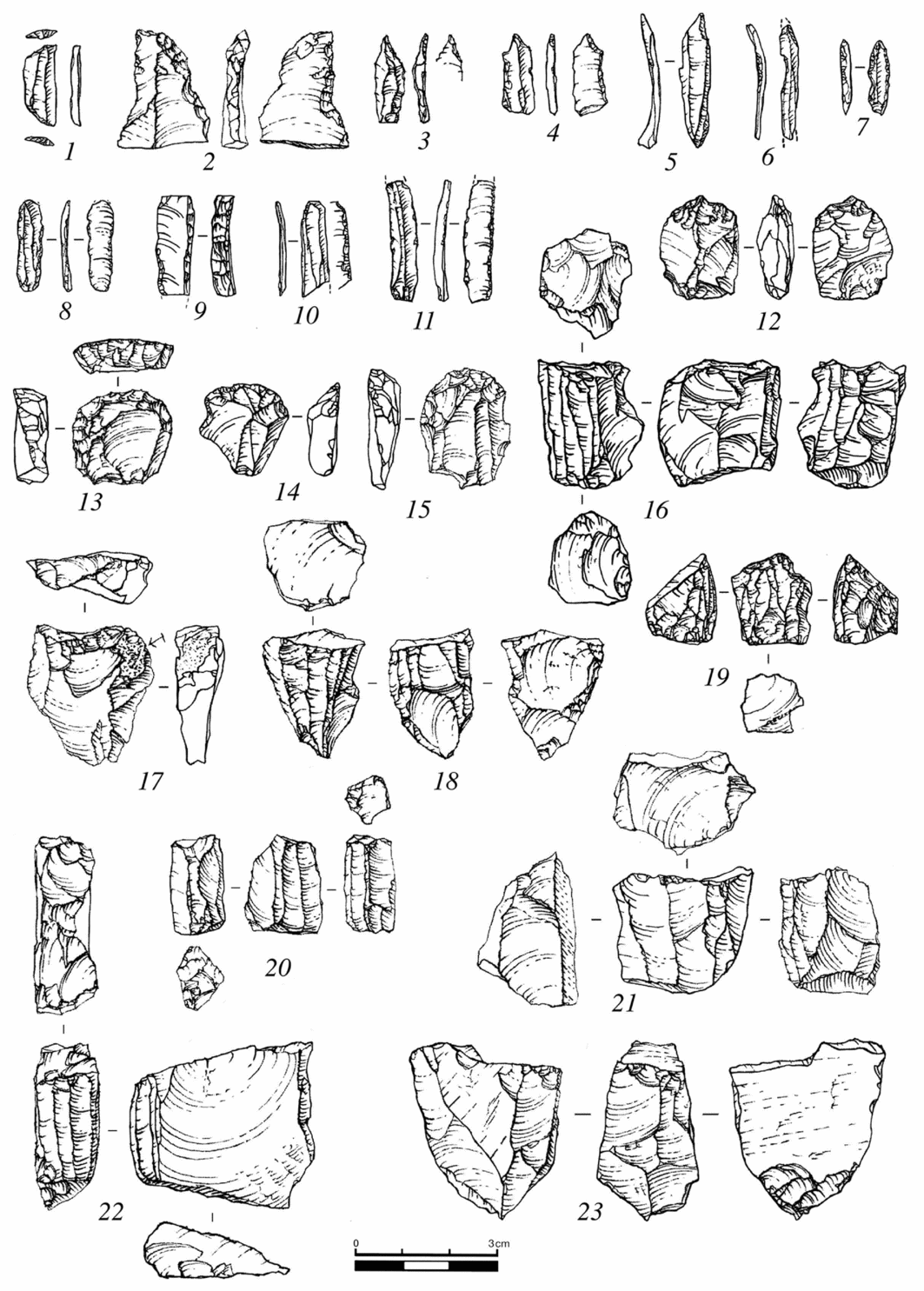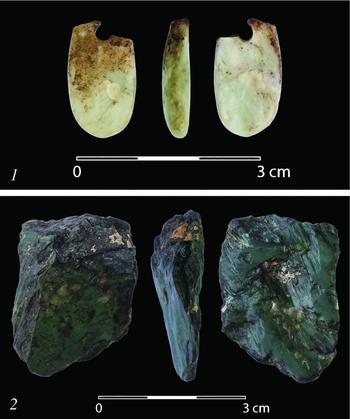Intensive research on the Mesolithic of western Central Asia began in the mid twentieth century, when the discovery of key sites allowed for the formulation of the main regional cultural-chronological schemes (Figure 1).

Figure 1. The location of archaeological sites mentioned in the article. Map produced using National Geographic Basemap and ArcGIS Online.
The assemblage from Obishir-5, a site located in the southern part of the Fergana Valley (in Batken District, south Kyrgyzstan; Figure 2) played a crucial role in archaeological interpretation. The site was discovered by U.I. Islamov in 1965, and a total area of 141m2 was excavated over seven field seasons during the 1960s–1970s.

Figure 2. Obishir-5, as seen from the east.
Between four and seven stratigraphic layers were identified in different parts of the site; layer 2 contained remains of the Late Iron Age—early medieval period (first to seventh centuries AD), while the lower layers (3–7) contained Mesolithic assemblages. The Mesolithic lithics and animal bones were analysed as one accumulation and dated to 9000–8000 BC. According to Islamov (Reference Islamov1980), the lithic industry is dominated by bladelets and microblades with alternate and ventral retouch, isolated segments and choppers.
In 2015, we started large-scale fieldwork as part of interdisciplinary studies of Epipalaeolithic settlements in western Central Asia. Obishir-5 was excavated in the framework of this project in 2015–2016, with further excavations planned in the following years. A total of 8m2 in the western part of U.I. Islamov's original excavation area (Figure 3) have so far been excavated. Six stratigraphic layers, mostly of colluvial origin, were revealed: layer 0, modern topsoil; layer 1, light grey to pale brown thin-laminated silt, containing archaeological material from the Early Middle Ages; layers 2 and 3, light brown to dark brown colluvial loam; layer 4, loess-like cream to yellowish-brown colluvial loams with limestone clasts; layer 5 can be considered as a typical loess that was most probably formed during the Last Glacial Maximum. Layers 2–5 contained Epipalaeolithic material. Three AMS 14C dates (Paleo Laboratory Ltd, Japan) are currently available for layers 1 and 2 (Table 1).

Figure 3. Stratigraphy and excavation plan of Obishir-5 (after the 2016 excavation). The numbering of layers does not follow the original numeration by Islamov (Reference Islamov1980).
Table 1. Radiocarbon dates from Obishir-5; given date ranges correspond to 1-sigma (68.2 per cent) probability range, calibrated using IntCal13 (OXCAL version 4.3).

The assemblage recovered from layers 2–5 includes more than 2200 lithic artefacts (Figure 4). Technical and typological analysis allowed us to define two distinct techno-complexes: one from layers 2–3, and the second from layers 4–5. The industry from layers 2–3 is characterised by the pressure knapping of bladelets from volumetric and narrow-faced cores. The toolkit consists of microblades with ventral retouch, perforators and notched tools, thumbnail endscrapers, micro splinted pieces and burins. A pendant and a pendant blank manufactured from local talcite and serpentinite were recovered from layer 2 (Figure 5). The closest source of these raw materials is situated approximately 4.5km from the site. Layer 2 also yielded human remains associated with the Epipalaeolithic of the region. The specimen is a right upper first deciduous incisor, quite worn and with a mostly resorbed root (Figure 6). We estimate the age of the individual at roughly six years, based on recent dental standards (Ubelaker Reference Ubelaker1978).

Figure 4. Lithic artefacts from Obishir-5.

Figure 5. Stone ornaments from Obishir-5.

Figure 6. The upper deciduous incisor from Obishir-5.
The lithic assemblage from layers 4–5 is characterised by volumetric and narrow-faced cores for bladelets, which were created by soft hammer percussion. The toolkit includes bladelets with dorsal retouch, backed bladelets and end-scrapers.
Comparative analysis suggests that the assemblages from layers 2–3 are similar to the Epipalaeolithic complexes from the central Tian-Shan area (Alamyshyk, Aygyrjal-2) and the Pamir region (Oshhona), which date to between 13000–7000 cal BP (Motuzaite Matuzeviciute et al. Reference Motuzaite Matuzeviciute, Preece, Wang, Colominas, Ohnuma, Kume, Abdykanova and Jones2017). The material from layers 4–5 has analogies with the Upper Palaeolithic sites of the Tian-Shan (Kurama, layers 1–2, Dodekatym-2, layers 2–4) and Pamiro-Alai regions (Khodja-Gor), with dates between 28000–23000 cal BP (Kolobova et al. Reference Kolobova, Krivoshapkin, Derevianko and Islamov2011).
These conclusions, however, must be regarded with caution, as the sediments of Obishir-5 bear traces of colluvial re-deposition, and the mixing of artefacts between layers cannot currently be excluded.
Materials from layers 2–3 enabled the identification of a new variant of Epipalaeolithic culture in the region, characterised by unique retouched bladelets and pressure knapping methods used during stone tool production. Using analogies with other sites, we believe that this unit may be widely spread, from the Pamir Mountains to the south and the Tian Shan to the north and east.
Until recently, a chronological and cultural gap between Late Pleistocene and Early Holocene peopling of western Central Asia has been hypothesised. The Upper Palaeolithic assemblages of Dodekatym-2 (Uzbekistan) and Kurama (Kyrgyzstan) (both dated to 23000 cal BP) are characterised by scalene triangles, Arzheneh points and backed bladelets, accompanied by carinated and single-platform cores. Several thousand years later in Central Asia, Mesolithic and Epipalaeolithic techno-complexes (20000 BP) with different types of geometric and non-geometric microliths appeared. The reassessment of Obishir-5, with its Final Pleistocene and Early Holocene assemblages, could illuminate questions of relationships between Upper Palaeolithic and Epipalaeolithic inhabitants. Our preliminary data is evidence for the cultural replacement of the industries, without any sign of transition. This area was occupied in the Upper Palaeolithic and Epipalaeolithic by various groups that produced differing lithic techno-complexes. Considering the scarcity of Upper Palaeolithic and Epipalaeolithic sites in western Central Asia, Obishir-5 represents the only source of information concerning the Final Pleistocene to Early Holocene transition in the region.
Acknowledgements
The analytical aspect of this research was supported by the Russian Science Foundation (project 14-50-00036). Support for field studies was provided by grants from the President of the Russian Federation (МD-2845.2017.6), the Russian Humanitarian Science Foundation (15-31-01000) and the Project of Altai State University (33.867.2017.ПЧ). Dating was performed courtesy of Katsuhiko Ohnuma, Kokusihikan University, Tokyo (‘Formation of Nomadic Societies in Ancient Eurasia’ Project).









